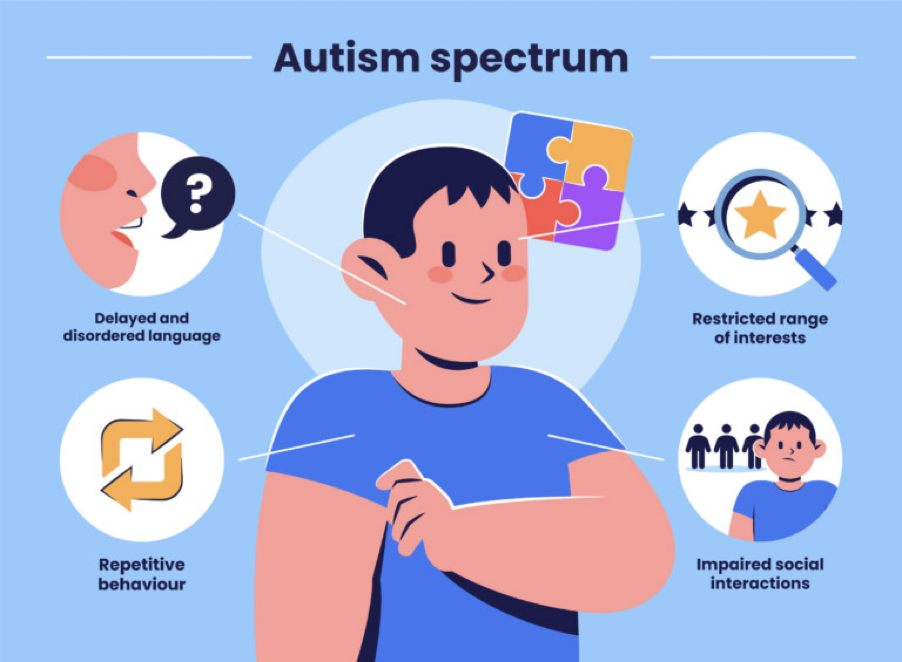
Introduction: Why Talk About Autism Today?
Autism Spectrum Disorder (ASD) has become one of the most important topics in mental health, education, and workplaces. Awareness is growing, but myths and misconceptions continue to create barriers for autistic individuals. This matters for everyone—students, professionals, educators, counselors, and families—because understanding autism is not just about knowledge; it’s about building inclusive communities. Think of your mind like a blank whiteboard. When misinformation about autism appears, we can lovingly erase it and replace it with truth and compassion.
What is Autism Spectrum Disorder (ASD)?
Autism Spectrum Disorder is a neurodevelopmental condition that affects how individuals communicate, process information, and experience the world. People on the spectrum may struggle with social communication, prefer routines, or have sensory sensitivities. But autism is called a spectrum because no two individuals are alike—each has unique strengths and challenges. Importantly, autism is not a disease to be cured; it is a difference in brain wiring that deserves understanding and acceptance.
Signs and Characteristics of Autism
Autism presents differently in children, teens, and adults, but some patterns are common. In children, early signs may include delayed speech, limited eye contact, repetitive behaviors, or strong attachment to routines. In teens and adults, it may show as difficulty interpreting social cues, sensory sensitivities, or a preference for structure and predictability. However, alongside challenges, many autistic individuals have exceptional memory, creativity, and attention to detail. Autism is not simply about what a person struggles with—it is also about what they bring as unique strengths.

Causes and Myths: What We Know (and Don’t Know)
Scientists believe autism arises from a mix of genetic and environmental factors that affect brain development. However, several myths still circulate and must be erased. Vaccines do not cause autism—this has been disproven by science. Parenting styles are not the cause either. Autism cannot and should not be “cured,” because it is not an illness, but a lifelong condition. Finally, autistic individuals are not all the same; autism exists on a wide spectrum. The more we clear away these myths, the more space we create for understanding and compassion.
Autism and Daily Life: Challenges and Strengths
Living with autism often means navigating both challenges and strengths. Challenges can include communication barriers, sensory overload in noisy or crowded environments, and distress when routines are disrupted. Social interactions may also feel overwhelming. Yet, autism also brings remarkable strengths—such as honesty, persistence, creativity, and strong focus on details. Recognizing both challenges and strengths helps shift the perspective from limitation to difference, opening the door to acceptance and growth.
Supporting Individuals with Autism
Support for autistic individuals looks different depending on who you are. Parents can help by creating safe routines, encouraging independence, and celebrating small milestones. Educators and school counselors can design inclusive classrooms, develop Individualized Education Plans (IEPs), and support social-emotional growth. Friends, peers, and colleagues can contribute by showing empathy, patience, and acceptance. Each act of understanding adds another line of kindness on the whiteboard of autism awareness.
Autism and Mental Health
Autistic individuals often face additional mental health challenges such as anxiety, depression, and stress—especially in environments that lack inclusivity. Misunderstanding, bullying, or exclusion can lead to emotional struggles. Psychological support plays a key role here. Modified Cognitive Behavioral Therapy (CBT), play therapy for children, social skills training, and family counseling are just some of the approaches that help. The goal is not to “fix” autism but to promote psychological safety, resilience, and well-being.

Autism in the Workplace
Workplaces are one of the biggest opportunities to embrace neurodiversity. Many autistic employees thrive in roles that require focus, attention to detail, and creative problem-solving. Companies such as Microsoft and SAP have launched neurodiversity hiring programs, recognizing the strengths autistic individuals bring. Employers can create inclusive spaces by offering clear communication, flexible work environments, and understanding different social interaction styles. By valuing neurodiversity, workplaces unlock innovation and loyalty.
Role of Psychology and Counseling in Autism
Psychology and counseling provide vital support for individuals with autism and their families. Early assessments help identify autism, enabling timely interventions. Therapies such as Applied Behavioral Analysis (ABA) and social skills training can help children adapt and thrive. Counseling also supports families in managing challenges and celebrating progress. Importantly, modern psychology emphasizes a strength-based approach—shifting away from outdated ideas of “fixing” autism and instead focusing on empowerment and growth.
Stories of Strength: Real-Life Examples
Stories of autistic individuals thriving remind us of the value of inclusion. Temple Grandin, a renowned scientist and author, used her unique perspective to transform the field of animal behavior. Many students, artists, and professionals succeed every day because of—not in spite of—their autism. Their determination and creativity show us that neurodiverse minds are powerful contributors to society. These stories inspire us to keep erasing stigma and replacing it with celebration.
Building an Inclusive Future: What We Can Do
The future of autism awareness depends on collective action. Schools can train teachers in inclusive education. Workplaces can expand neurodiversity hiring programs. Communities can host autism-friendly events and create sensory-friendly spaces. On an individual level, we can all practice empathy, patience, and respect. Each step—whether large or small—helps create a more inclusive future where autistic individuals feel accepted and supported.
Conclusion: Rewriting the Narrative of Autism
Autism is not a flaw—it is a different way of experiencing life. With awareness, acceptance, and the right support, autistic individuals can thrive in school, at work, and in relationships. Remember the whiteboard metaphor: whenever misconceptions appear, we can wipe them away and replace them with truths of empathy, compassion, and inclusion. The real question is: what will you choose to write on your whiteboard today about autism?